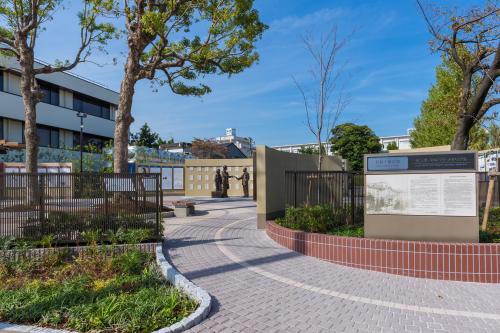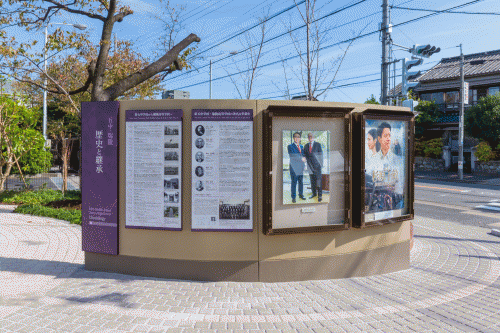本文
Chiune Sugihara Square AICHI PREFECTURE “SEMPO” SUGIHARA MEMORIAL

■DATE OF ESTABLISHMENT:
Oct.12, 2018
■LOCATION:
Aichi Prefecture Zuiryo High School, main gate, on the west side, 2-1 Kitahara-cho, Mizuho-ku, Nagoya, Aichi, Japan
■ACCESS from JR Nagoya station:
・By subway
Sakura-dori Subway Line- about 400m west from the Mizuho Kuyakusho Station
・By taxi
About 9 km, 20 minutes
Please visit using public transportation.
This Square does not have parking or toilet facilities.
■CONTACT INFORMATION:
kyoiku-somu@pref.aichi.lg.jp
General Affairs Division, Aichi Prefectural Board of Education
1 Entrance

Greeting from the Governor:
During the turbulent times of World War II, Mr. Chiune Sugihara risked his own career to follow his personal beliefs and save the lives of many.
Mr. Sugihara’s courageous acts serve to highlight the amazing potential and strength of human beings.
I am extremely proud of the fact that Mr. Sugihara, who has left such a strong humanitarian legacy, studied for ten years in our very own Aichi Prefecture, at Furuwatari Elementary School and the Fifth Middle School (present day Zuiryo High School).And now, after more than three years of preparation, we celebrate the establishment of Chiune Sugihara Square, Aichi Prefecture “Sempo” Sugihara Memorial at Zuiryo High School, the school that carries on the spirit of the school Mr. Sugihara attended.
The name "Sempo Sugihara Memorial" was suggested by a current student at Zuiryo High School. Mr. Sugihara signed “Sempo Sugihara” on a postcard he sent to his former classmate from the Fifth Middle School from Moscow in 1973.
On display in this square are a wide range of materials relating to Mr. Sugihara’s accomplishments, including a bronze statue depicting him handing a visa to a Jewish family, visa lists from Kaunas and Prague, images and records of the Fifth Middle School at the time of his enrollment, records showing his achievements as a diplomat, and a history of the individuals who aided the Jewish refugees.
Through commemorative exhibitions such as this, it is my sincere wish that we can convey to people in Japan and around the world, especially the younger generation, that the legacy of Sugihara’s humanitarian actions remains deeply engraved in the hearts of those who were saved, as well as their descendants. I also hope that this exhibition reveals how the courageous actions of one human being may profoundly change the lives of many.
As citizens of Aichi Prefecture, we could have no greater pleasure than for this square to be visited by people from around the world, and for it to become a significant place as we work toward world peace.
We could not have established this square without the assistance of many people, both in Japan and abroad, starting with the Sugihara family.
I would like to express my gratitude to you all for your generous, warm cooperation.
Hideaki Ohmura
Governor of Aichi Prefecture
October 12, 2018
2 The Humanitarian Decision and Hope for the Jews




CONTENTS:
A bronze statue of Sugihara and a Jewish family, the Kaunas and Prague visa lists, an interview with Sugihara, and selected stories of visa recipients
Introduction:
In September 1939, with the German and Soviet armies invading Poland, many Jews fled to neighboring Lithuania and became refugees. When the Soviet Union later annexed Lithuania and the German threat continued to advance, Jewish refugees searched for a way to get a Japanese transit visa and to escape to a third country.
Then, in July 1940, a Jewish refugee rushed into the Japanese Consulate in Kaunas, Lithuania looking for a visa. After some hesitation, Vice Consul Sugihara began to issue visas to Jewish refugees against the orders of the Ministry of Foreign Affairs.
Those who received visas from Sugihara now had hope of escaping the country. However, many more Jews were unable to obtain visas and later lost their lives in the Holocaust.
A bronze statue of Chiune Sugihara and a Jewish family:
“Through this statue of Chiune Sugihara and three members of a Jewish family, I hope to visually covey Mr. Sugihara’s humanitarian deeds as represented by his act of issuing visas to Jewish people, which facilitated their departure and ultimately allowed them and their children to live full lives. I have produced this work with the wish that their joyful cries will continue to resonate in people’s hearts.”
October, 2018,
Hokuyuu Narahara,
Sculpor
Excerpt from an interview with Sugihara(The Circumstances of Issuing the Visas):
“I told them it was a matter of humanity.
I did not care if I lost my job.
Anyone else would have done the same thing if they were in my place.
There was no other way.
That is why I issued the visas.”
(From the Voice of Chiune Sugihara in Moscow in August, 1977)
Selected stories of visa recipients:
(Kaunas Visa List)
No.299 Salomon-Boruck-Szmul (Bernard Salomon) (excerpt from an essay by Mark Salomon, Bernard’s grandson)
No.2 Moses Kaplan
No.455 Zorach Warhaftig
No.1225 Moses Zupnik
No.1506 Markus Nowogrodzki
No.1758 Fejga Melamdowicz, No.1768 Icchock Melamdowicz
No.1822 Mieczyslaw Lampert
(Prague Visa List)
No.12 Oskar Izrael Stossinger, No.13 Irena Sara Stossinger
The Visa Lists:
In the latter half of 1940, many Jewish refugees who had entered Japan with a transit visa (a visa that permits the holder to enter a country on the way to their destination country) found themselves stuck in Japan because they were unable to secure the visas or travel expenses needed to get to their final destinations. On February 4, 1941, the Ministry of Foreign Affairs, concerned about the gravity of the situation, sent a telegram to Sugihara, who was Acting Consul-General in Prague, to inquire about the number of visas issued at Kaunas, in particular the number of visas issued to Jewish refugees. Sugihara immediately reported the number of visas issued to the Ministry of Foreign Affairs, and then sent a list of issued transit visas about one month later. After moving from Kaunas to the Japanese Consulate in Prague, Sugihara continued to issue visas to Jewish refugees.
We exhibited all pages of the Visa Lists on the wall.
List of Transit Visas Issued in Kaunas:
This is the list of Japanese transit visas issued by Sugihara at the Consulate of Japan in Kaunas from July to August 1940. From left to right, information is laid out as follows: serial number, nationality, full name, visa category, entrance or transit, date of visa, and visa fee (in Litas). Sugihara informed the Ministry of Foreign Affairs that 2,132 visas were issued in Kaunas, of which approximately 1,500 had been issued to Jewish refugees. In the visa issuance list that was sent later, the final number was 2,139. However, a detailed study of the list found missing numbers and duplications and thus showed that the actual number of visas issued was 2,140.
List of Visas Issuued in Prague:
The list issued by the Consul-General of Japan in Prague, Czechoslovakia included both transit visas and entry visas to Japan issued between January 1940 and February 1941. In the case of transit visas, destination countries other than the United States included Latin American countries such as Brazil and Mexico. After being transferred from Kaunas, Sugihara issued 73 more visas to Jewish refugees at the Consulate General of Japan in Prague. The visas that were issued before Sugihara took his post on September 12, 1941, were issued by his predecessor, the acting Consul-General Kozo Ichige.
3 The Life-Saving Visas
(The Visa Issuance Process, The Route of Jewish Refugees)

CONTENTS:
The historic background leading up to visa issuance, evacuation routes for Jewish refugees and their supporters, and diplomats from various countries who helped save Jewish lives
Display panel:
1 The Evacuation of Jewish Refugees to Lithuania
2 Jan Zwartendijk, Dutch Consular Officer in Kaunas
3 Issuing Visas at the Japanese Consulate in Kaunas
4 Acting Consul-General of Japan in Vladivostok, Saburo Nei
5 Arrival in Tsuruga
6 Jewish Refugees in Kobe
7 Setsuzo Kotsuji, a Supporter of Jewish Refugees in Japan
8 Diplomats from Various Countries Who Helped Save Jewish Lives
4 The Life of Chiune Sugihara
(Formative Years, Diplomatic Work)

CONTENTS:
Sugihara’s childhood, time at the Aichi Prefecture Fifth Middle School, progress as a diplomat, and life as a civilian in post-war Japan
Display panel:
1 Childhood Through Enrollment at Aichi Prefecture Fifth Middle School 1900‒1912
2 At the Aichi Prefecture Fifth Middle School 1912‒1917
3 Waseda University and Study Abroad through the Ministry of Foreign Affairs 1918‒1925
4 Posts at the Japanese Consulate General in Harbin and the Japanese Legation in Finland 1925‒1939
5 The Consulate of Japan in Kaunas 1939‒1940
6 Consulates General of Japan in Prague and Königsberg 1940‒1941
7 Japanese Legation in Romania and Life as a Civilian in Post-War Japan 1941‒1986
5 The Chronology of Zuiryo High School

CONTENTS:
The transition from Aichi Prefcture Fifth Middle School to Zuiryo High school, and well-known alumni of the school
Display panel:
1 From Aichi Prefecture Fifth Middle School to Zuiryo High School
2 Well-known Alumni from Aichi Prefecture Fifth Middle School and Zuiryo High School

